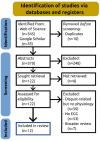Review of the gastric physiology of disgust: Proto-nausea as an under-explored facet of the gut-brain axis
- PMID: 39711753
- PMCID: PMC11662309
- DOI: 10.1177/23982128241305890
Review of the gastric physiology of disgust: Proto-nausea as an under-explored facet of the gut-brain axis
Abstract
Humans feel visceral disgust when faced with potential contaminants like bodily effluvia. The emotion serves to reject potentially contaminated food and is paired with proto-nausea: alterations in gastric rhythm in response to disgust. Here, we offer a narrative synthesis of the existing literature on the effects of disgust on the stomach as measured through electrogastrography, a non-invasive technique that measures stomach activity with electrodes placed on the abdominal skin surface. After identifying and assessing 368 studies for eligibility and inclusion based on the Preferred Reporting Items for Systematic Reviews and Meta-Analyses process, we reviewed a final sample of only 10 articles that employed electrogastrography to assess gastric responses to unpleasant stimuli, including disgust elicitors. Reviewed findings illustrate that changes in gastric rhythm are associated with negatively valenced emotions, and most reliably with visceral disgust elicitors. This rhymes with recent evidence for a causal role of gastric state in reductions in visceral disgust avoidance. Because limitations in the reviewed body of work come from the low number of studies and relatively small sample sizes, we strongly encourage studies of proto-nausea in designs with higher statistical power, ideally paired with experimental manipulations of gastric state.
Keywords: Disgust; electrogastrography; emotion; gastric rhythm; gut–brain axis.
© The Author(s) 2024.
Conflict of interest statement
The author(s) declared no potential conflicts of interest with respect to the research, authorship and/or publication of this article.
Figures
References
-
- Angyal A. (1941) Disgust and related aversions. Journal of Abnormal and Social Psychology 36(3): 393–412.
-
- Armstrong T, Wilbanks D, Leong D, et al.. (2021) Beyond vernacular: Measurement solutions to the lexical fallacy in disgust research. Journal of Anxiety Disorders 82(Special issue): 102408. - PubMed
-
- Baldaro B, Mazzetti M, Codispoti M, et al.. (2001) Autonomic reactivity during viewing of an unpleasant film. Perceptual and Motor Skills 93(3): 797–805. - PubMed
Publication types
LinkOut - more resources
Full Text Sources


